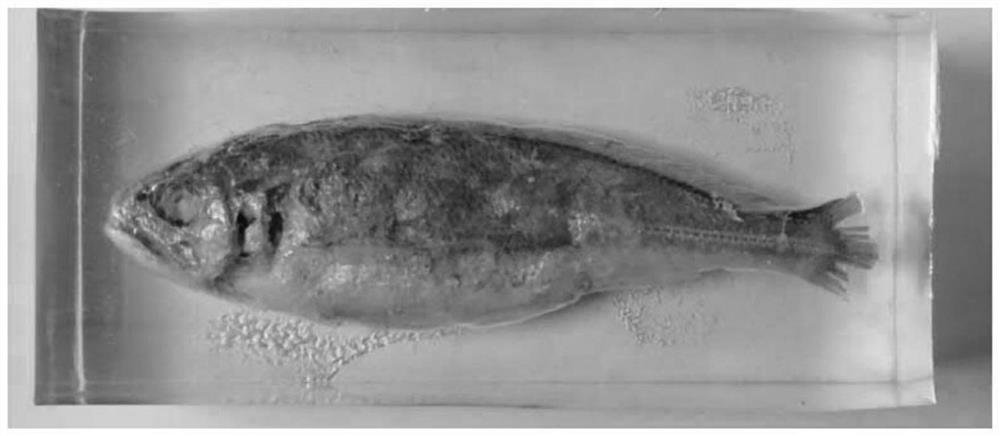Fish specimen making method
A technology for specimens and fish, applied in the field of fish specimen production, can solve the problems of cumbersome process of stripping specimens, difficult to restore the true state of fish, and high technical level requirements of production personnel, and achieves convenient transportation, stable state and preservation method. simple effect
- Summary
- Abstract
- Description
- Claims
- Application Information
AI Technical Summary
Problems solved by technology
Method used
Image
Examples
Embodiment 1
[0025] Example 1 Yellow flower specimen
[0026] Tipype in the refrigerator in the water to make the specimen, but it should be carried out in a fish specimen.
[0027] 1, fish condition fixation: use the filter paper to dry the surface, and unfold the drying area of the fins and other folded regions, apply the UV resin glue (UV glue) to the unfolded fish fin area and use the UV lamp to illuminate 30s, so that the UV glue Solidifying the fins, using the same method to unfold all the fish fins (including the fish tail) with UV glue, and then applying the fish with a UV resin glue with a brush and placed UV glue.
[0028] 2, epoxy resin seal: the fish filled with UV glue with α-cyanoacrylate adhesive adhesive to the bottom surface of the silicone mold, and then the A glue (epoxy) B glue (polyether) Amine D-230), AB glue mass ratio is 2.5: 1, stir mixed to no bristles, place the mixed liquid in an oven for 30 minutes, then pour it into the mold of lam, stand to be mixed Subsequent ...
Embodiment 2
[0032] Example 2: Daruto six-wire fish specimen
[0033] Put the cultured live Dabi six fish in sealing the storage box, and then freeze half an hour in the -28 ° C refrigerator, and take it out of the water to perform the thaw, and then produce it.
[0034] 1. Fish status. Delicate the six-wire fish to dry the surface, and expand the folded area of the fish fin to suck the moisture, apply UV resin to the unfolded fish fin area and use the UV lamp to illuminate 30s, so that the UV glue is solidified to fix the fish fin, use The same method unfoldes all the fatches (including the fish tail) and fixed with UV glue, and then applying the fish with a brush to the UV resin glue, which is placed under the UV lamp to solidify.
[0035] 2. Epoxy resin is sealed. The fish seal with UV glue with alpha-cyanoacrylate adhesive to the bottom surface of the silicone mold, and then the A glue (epoxy resin) B glue of the mixed collapse (polyether amine D-230), AB The glue mass ratio was 3: 1, st...
PUM
 Login to View More
Login to View More Abstract
Description
Claims
Application Information
 Login to View More
Login to View More - R&D
- Intellectual Property
- Life Sciences
- Materials
- Tech Scout
- Unparalleled Data Quality
- Higher Quality Content
- 60% Fewer Hallucinations
Browse by: Latest US Patents, China's latest patents, Technical Efficacy Thesaurus, Application Domain, Technology Topic, Popular Technical Reports.
© 2025 PatSnap. All rights reserved.Legal|Privacy policy|Modern Slavery Act Transparency Statement|Sitemap|About US| Contact US: help@patsnap.com


